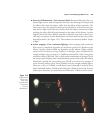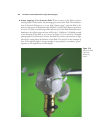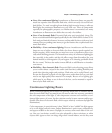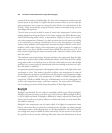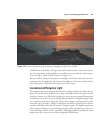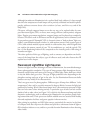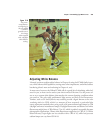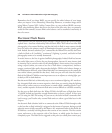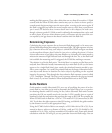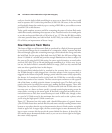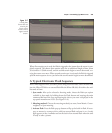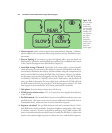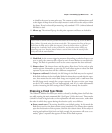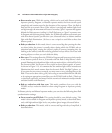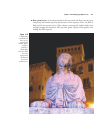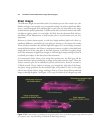making the flash exposure. Then, after a delay that can vary from 30 seconds to 1/250th
second (with the Nikon D7000; other cameras may sync at a faster or slower speed), a
second curtain begins moving across the sensor plane, covering up the sensor again. If
the flash is triggered just before the second curtain starts to close, then second-curtain
sync is used. (I’ll describe these in more detail later in this chapter.) In both cases,
though, a shutter speed of 1/250th second is ordinarily the maximum that can be used
to take a photo. If you use a faster shutter speed, you’ll expose only the part of the sen-
sor exposed by the gap between the shutter curtains when the flash fires.
Determining Exposure
Calculating the proper exposure for an electronic flash photograph is a bit more com-
plicated than determining the settings for continuous light. The right exposure isn’t sim-
ply a function of how far away your subject is (which the D7000 can figure out based
on the autofocus distance that’s locked in just prior to taking the picture). Various
objects reflect more or less light at the same distance so, obviously, the camera needs to
measure the amount of light reflected back and through the lens. Yet, as the flash itself
isn’t available for measuring until it’s triggered, the D7000 has nothing to measure.
The solution is to fire the flash twice. The initial shot is a monitor pre-flash that can be
analyzed, then followed virtually instantaneously by a main flash (to the eye the bursts
appear to be a single flash) that’s given exactly the calculated intensity needed to pro-
vide a correct exposure. As a result, the primary flash may be longer in duration for dis-
tant objects and shorter in duration for closer subjects, depending on the required
intensity for exposure. This through-the-lens evaluative flash exposure system is called
i-TTL (intelligent Through The Lens), and it operates whenever the pop-up internal
flash is used, or you have attached a Nikon dedicated flash unit to the D7000.
Guide Numbers
Guide numbers, usually abbreviated GN, are a way of specifying the power of an elec-
tronic flash in a way that can be used to determine the right f/stop to use at a particu-
lar shooting distance and ISO setting. In fact, before automatic flash units became
prevalent, the GN was actually used to do just that. A GN is usually given as a pair of
numbers for both feet and meters that represent the range at ISO 100. For example, the
Nikon D7000’s built-in flash has a GN in i-TTL mode of 12/39 (meters/feet) at ISO
100. To calculate the right exposure at that ISO setting, you’d divide the guide number
by the distance to arrive at the appropriate f/stop.
Using the D7000’s built-in flash as an example, at ISO 100 with its GN of 39, if you
wanted to shoot a subject at a distance of 10 feet, you’d use f/3.9 (39 divided by 10),
rounded to f/4. At 5 feet, an f/stop rounded to f/8 would be used. Some quick mental
calculations with the GN will give you any particular electronic flash’s range. You can
Chapter 12 ■ Making Light Work for You 407



